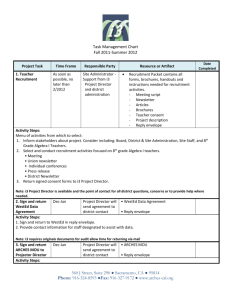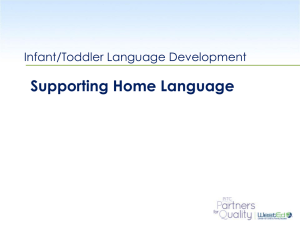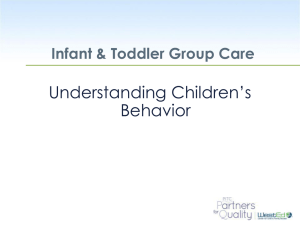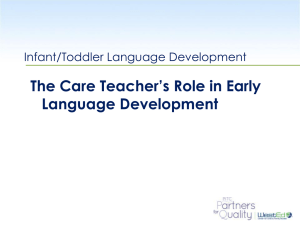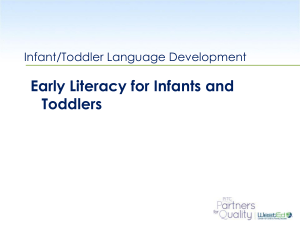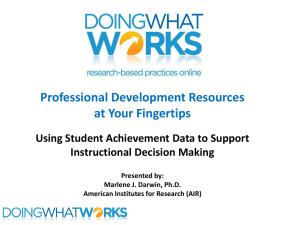Scaffolding the Academic Success of English Language Learners: A Pedagogy of Promise
advertisement
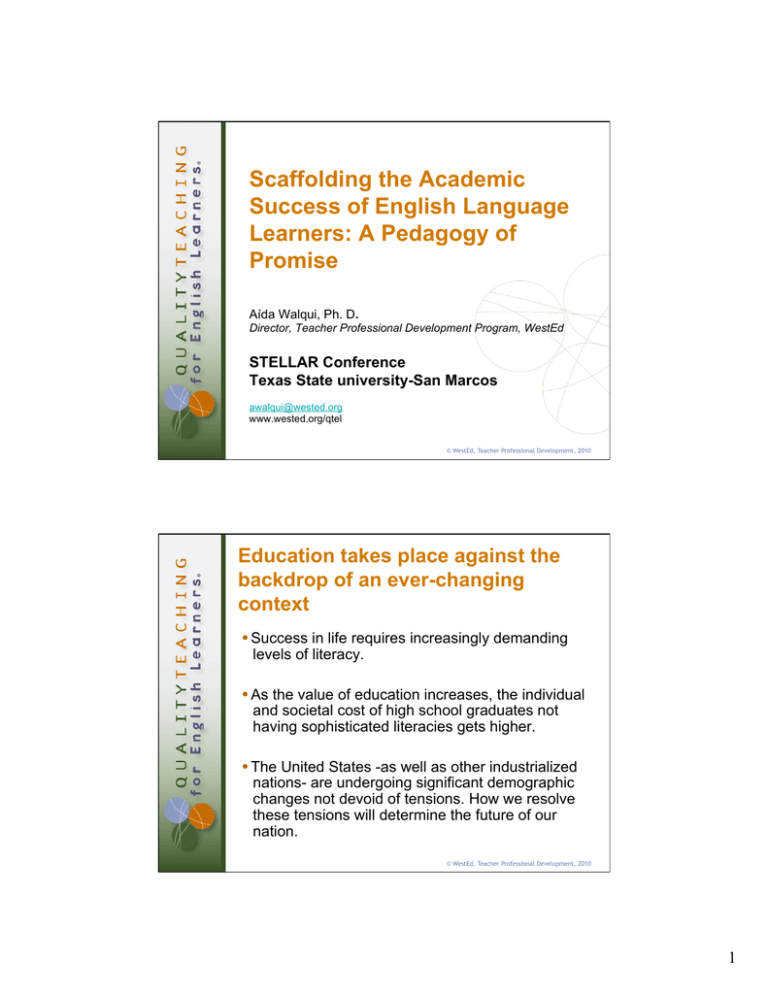
Scaffolding the Academic Success of English Language Learners: A Pedagogy of Promise Aída Walqui, Ph. D. Director, Teacher Professional Development Program, WestEd STELLAR Conference Texas State university-San Marcos awalqui@wested.org www.wested.org/qtel © WestEd, Teacher Professional Development, 2010 Education takes place against the backdrop of an ever-changing context • Success in life requires increasingly demanding levels of literacy. • As the value of education increases, the individual and societal cost of high school graduates not having sophisticated literacies gets higher. • The United States -as well as other industrialized nations- are undergoing significant demographic changes not devoid of tensions. How we resolve these tensions will determine the future of our nation. © WestEd, Teacher Professional Development, 2010 1 From Literacy to Multiple Literacies Literacy is defined as the ability to interpret a wide variety of texts, understanding their messages, the messengers’ points of view, the relationship of the interpreter to the message, as well as deciding how to respond to them appropriately. Literacy includes all the elements of reading, writing, speaking, listening, critical thinking, engaging in new learning, and the habits of mind that foster effective civic participation. Oral literacy (oracy), financial literacy, school literacy, bilingual literacy and disciplinary literacy constitute some examples of literacies that American schools need to develop. © WestEd, Teacher Professional Development, 2010 The mastering of multiple literacies: Is a long-term developmental process. End goal: read and produce a variety of materials with ease and interest, for varying purposes, with comprehension even when materials may be difficult and not intrinsically interesting. Thus possessing multiple literacies consists of extracting and constructing meaning through interaction and involvement of varied types with a wide variety of texts. © WestEd, Teacher Professional Development, 2010 2 Why principled practice? Quality learning and teaching occurs when deep understandings about subject matter, pedagogy, students, the language which is the medium of instruction, and the context combine with a vision for excellence and are actualized in response to particular situations. Good teaching then, is always situated in the particular. Principles enable us to account for the quality of teaching across different settings and show that instances of excellent teaching can occur in a variety of ways. © WestEd, Teacher Professional Development, 2010 Principles of Quality Teaching for English Learners They share many of the same characteristics as general pedagogical principles but they have a special focus on the processes needed by second language learners to arrive at academic excellence. © WestEd, Teacher Professional Development, 2010 3 Principles of Quality Teaching for English Learners Sustain Academic Rigor in teaching English Learners Hold High Expectations in teaching English Learners Engage in Quality Interactions with English Learners Sustain a Language Focus in teaching English Learners Develop Quality Curricula for teaching English Learners © WestEd, Teacher Professional Development, 2010 Sustain Academic Rigor in Teaching ELs Promote deep disciplinary knowledge • Develop central ideas of a discipline • Establish complex relations between central ideas • Sustain focus on central ideas and balance in depth of knowledge Use higher order thinking skills • Students combine facts and ideas to synthesize, evaluate, generalize • Students solve problems and construct new meaning and understandings Develop substantive, generative concepts and skills, and support thinking with evidence • Develop complex understandings of central concepts • Construct explanations and arguments in the discipline © WestEd, Teacher Professional Development, 2010 4 Hold High Expectations in Teaching ELs Engage students in tasks that are high challenge and high support • Use tasks that are academically challenging and engaging • Provide scaffolds that facilitate student engagement in intellectual tasks • Provide varied entry points for instructional tasks • Promote apprenticeship and increased participation over time Engage students in the development of their own expertise • Act on the belief that all members of a class community can achieve • Foster a climate of mutual respect that contributes to the achievement of all Have clear criteria for high expectations • Be explicit about the criteria for what constitutes quality performance • Be clear with students that it is necessary to take risks and work hard to master challenging academic work © WestEd, Teacher Professional Development, 2010 Engage in Quality Interactions with ELs Engage in sustained, deep interactions to build knowledge • Dialogue between teacher and student and between peers is sustained and builds on the participants’ ideas to promote improved understanding of concepts • Dialogue involves the exchange of ideas and is not scripted or dominated by one party Jointly construct knowledge mediated through language • Talk is about the subject matter of the discipline and encourages reasoning, application of ideas, argumentation, forming generalizations, and asking questions © WestEd, Teacher Professional Development, 2010 5 Sustain a Language Focus in Teaching ELs • Explicitly develop disciplinary language • Explicitly discuss how language works and characteristics of language, texts, and disciplinary discourse • Provide deliberately crafted opportunities for students to practice new concepts and language purposefully • Focus student performance and corrective feedback on: fluency, complexity, OR accuracy • Amplify, don’t simplify (linguistically, paralinguistically, extralinguistically) © WestEd, Teacher Professional Development, 2010 Develop a Quality Curriculum for teaching ELs • Curriculum has long term goals that include benchmark moments • Curriculum is problem-based and requires knowledge construction and sustained attention beyond a single lesson • Curriculum spirals, enabling students to increasingly deepen their understanding of new concepts, new language and new skills, and enabling students to move from ambiguity to increasing clarity • Curriculum weaves knowledge in ways that interconnect the world around him/her • Curriculum builds from the students’ linguistic and cultural knowledge and group identities © WestEd, Teacher Professional Development, 2010 6 Viewing With a Focus Lens: You will be assigned one of the following QTEL Principles : Quality Interactions High Expectations Find concrete evidence of this dimension in the video. Jot it down for discussion. © WestEd, Teacher Professional Development, 2010 Where do you want to go next? School: International High School, La Guardia Community College Students: 9th and 10th graders Humanities class. In the U.S. between three weeks and two and a half years Teacher: Anthony DeFazio © WestEd, Teacher Professional Development, 2010 7 Pedagogies of Promise: Realizing Students’ Potential • Development follows learning (therefore, instruction precedes development) • Participation in activity is central in the development of knowledge • Participation in activity progresses from apprenticeship to appropriation, from the social to the individual plane • Learning can be observed as changes in participation over time © WestEd, Teacher Professional Development, 2010 Understanding Learning/Teaching Zones: QTEL Pedagogy (Walqui, 2007, adapted from Mariani, 1997 and Hammond & Gibbons, 2007) high challenge ‘FRUSTRATION’ ZONE ‘APPRENTICESHIP’ ZONE (ZPD) low support high support ‘TWILIGHT’ ZONE ‘POBRECITO’ ZONE low challenge © WestEd, Teacher Professional Development, 2010 8 Students learn by participating in well-constructed interactions © WestEd, Teacher Professional Development, 2010 Similarly, through well-constructed subjectspecific interactions teachers develop their Subject Matter Knowledge, Pedagogical Knowledge, and Pedagogical SMK © WestEd, Teacher Professional Development, 2010 9 Let Us Analyze Another Class and a Very Different Context To observe: • Language Focus • Quality Interactions • Quality Curricula © WestEd, Teacher Professional Development, 2010 The Oral Development Jigsaw Teacher has scaffolded understanding of the genre: Description • Discussion of purpose: why do people describe scenes to others? • Structure: Where does the scene take place? Who is the central character(s) in the picture? What does this person look like (approximate age,gender, height, face, hair, clothes)? What is this person doing? Any other relevant information? © WestEd, Teacher Professional Development, 2010 10 Teacher has also offered students models of the language they may use: This scene takes place in … My picture shows … The picture I have shows a … The central character in my picture is In my picture you can see a … © WestEd, Teacher Professional Development, 2010 Jigsaw Project BASE GROUP Students work in heterogeneous groups and review the genre of description EXPERT GROUP Picture A Picture B Picture C Picture D Students describe their pictures following guidelines and models © WestEd, Teacher Professional Development, 2010 11 Jigsaw Project BASE GROUP Students work in heterogeneous groups and review the genre of description: purpose, structure, linguistic characteristics EXPERT GROUP Picture A Picture B BASE GROUP Picture C Picture D Students share their descriptions. Then discuss the genre of narrative to create one © WestEd, Teacher Professional Development, 2010 Now students apprentice a second Genre: Narratives… Short Stories Purpose: Why do people tell stories? Structure: Setting, title There is a central character, the protagonist (and other character/s) Something happens to the character Resolution The event transforms the character Language: Connectors related to time: Once upon a time, then, after that, suddenly, etc…; verbs in the past tense... © WestEd, Teacher Professional Development, 2010 12 Video Exemplar 2 Teacher: Roza Ng School: MS 131, Chinatown, NYC Class: Intermediate ESL Students: Between 6 months and 3 years in the U.S. © WestEd, Teacher Professional Development, 2010 The Oral Development Jigsaw in Roza Ng’s Class: An example of Quality Curriculum Discussion of the purpose and generic structure of descriptions Students jointly create a description Individually students share oral descriptions with new groups Discussion of the purpose and generic structure of narratives Collaboratively students construct an oral narrative Students jointly write their narrative Narratives are performed Independent written narrative ©©WestEd, WestEd, Teacher Teacher Professional Professional Development, Development, 2010 2010 13 Assessing the difficulty of a task adapted from: Brown, Anderson,Shillcock, and Yule. 1984. Teaching Talk. Strategies for Production and Assessment. Cambridge, UK: Cambridge University Press. Degree of difficulty Dynamic task Abstract task Task A Task B Task C Description of one scene Description of 4 different scenes Construction of a narrative Degree of difficulty Static task Many elements, relationships, characters, etc. (more difficult) Few elements, relationships, etc. (less difficult) © WestEd, Teacher Professional Development, 2010 Academic Uses of English Development Continuum This development should be tracked over a unit of work that takes place over several classes. More written More spoken Gibbons, (2009); Walqui & van Lier, (2010) © WestEd, Teacher Professional Development, 2010 14
